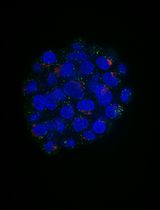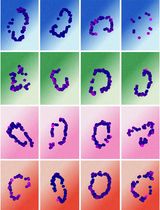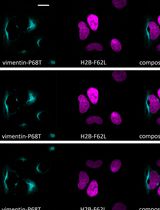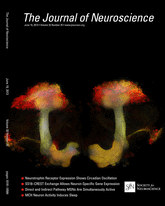- Submit a Protocol
- Receive Our Alerts
- Log in
- /
- Sign up
- My Bio Page
- Edit My Profile
- Change Password
- Log Out
- EN
- EN - English
- CN - 中文
- Protocols
- Articles and Issues
- For Authors
- About
- Become a Reviewer
- EN - English
- CN - 中文
- Home
- Protocols
- Articles and Issues
- For Authors
- About
- Become a Reviewer
Proteasome Assay in Cell Lysates
Published: Vol 4, Iss 2, Jan 20, 2014 DOI: 10.21769/BioProtoc.1028 Views: 13431
Reviewed by: Xuecai Ge

Protocol Collections
Comprehensive collections of detailed, peer-reviewed protocols focusing on specific topics
Related protocols

An Automated Imaging Method for Quantification of Changes to the Endomembrane System in Mammalian Spheroid Models
Margaritha M. Mysior and Jeremy C. Simpson
Jun 5, 2025 1602 Views

Quantifying Intracellular Distributions of HaloTag-Labeled Proteins With SDS-PAGE and Epifluorescence Microscopy
Julia Shangguan and Ronald S. Rock
Jul 20, 2025 2450 Views

Fluorescence Lifetime-Based Separation of FAST-Labeled Cellular Compartment
Aidar R. Gilvanov [...] Yulia A. Bogdanova
Oct 5, 2025 1297 Views
Abstract
The ubiquitin-proteasome system (UPS) mediates the majority of the proteolysis seen in the cytoplasm and nucleus of mammalian cells. As such it plays an important role in the regulation of a variety of physiological and pathophysiological processes including tumorigenesis, inflammation and cell death (Ciechanover, 2005; Kisselev and Goldberg, 2001). A number of recent studies have shown that proteasome activity is decreased in a variety of neurological disorders including Parkinson's disease, Alzheimer's disease, amyotrophic lateral sclerosis and stroke as well as during normal aging (Chung et al., 2001; Ciechanover and Brundin, 2003; Betarbet et al., 2005). This decrease in proteasome activity is thought to play a critical role in the accumulation of abnormal and oxidized proteins. Protein clearance by the UPS involves two sequential reactions. The first is the tagging of protein lysine residues with ubiquitin (Ub) and the second is the subsequent degradation of the tagged proteins by the proteasome. We herein describe an assay for the second of these two reactions (Valera et al., 2013). This assay uses fluorogenic substrates for each of the three activities of the proteasome: chymotrypsin-like activity, trypsin-like activity and caspase-like activity. Cleavage of the fluorophore from the substrate by the proteasome results in fluorescence that can be detected with a fluorescent plate reader.
Keywords: Nerve cellsMaterials and Reagents
- Cells
- HEPES (Sigma-Aldrich, catalog number: H3375 )
- MgCl2 (Sigma-Aldrich, catalog number: M2670 )
- EDTA (Sigma-Aldrich, catalog number: E5134 )
- EGTA (Sigma-Aldrich, catalog number: E4378 )
- Sucrose (MP Biomedicals, catalog number: 821713 )
- DTT (Life Technologies, catalog number: 15508013 )
- Proteasome substrates [dissolved in DMSO (Sigma-Aldrich, catalog number: D8418 ) to a final concentration of 10 mM and stored frozen at -20 °C]
- PBS without Ca2+ and Mg2+ (Sigma-Aldrich, catalog number: P802)
- Coomassie Protein Assay Reagent (Thermo Fisher Scientific, catalog number: 1856209 )
- BSA protein standard (Thermo Scientific, catalog number: 23209 )
- ATP (Sigma-Aldrich, catalog number: A3377 )
- Proteasome Lysis/Assay Buffer (see Recipes)
Equipment
- 60 mm tissue culture dishes
- Rubber policeman or other type of cell scraper
- 1.7 ml microcentrifuge tube
- Black walled 96 well plates (Corning, Costar®, catalog number: 3603 )
- Clear 96 well plates (Greiner Bio-One GmbH, catalog number: 655101 )
- Sonicator (GlobalSpec, model: W-380 )
- Microcentrifuge
- Fluorescent plate reader
- Visible plate reader
Procedure
- Sample Preparation
- Rinse cells in 60 mm dishes 2 times with ice cold PBS.
- Scrape cells using a rubber policeman or other type of cell scraper into 400 µl lysis buffer, transfer to a 1.7 ml microcentrifuge tube and place on ice.
- Sonicate for 10 sec using microtip set on ~2.
- Centrifuge at 16,000 x g for 10 min at 4 °C.
- Transfer supernatant to a fresh 1.7 ml microcentrifuge tube (can store at -70 °C until use in assay).
- Rinse cells in 60 mm dishes 2 times with ice cold PBS.
- Assay
- Prepare assay buffer (make up more than you need; e.g. if you need 3 ml, make 3.5 ml).
- Add proteasome substrates to assay buffer (2.5 µl/sample; 100 µM final concentration) (make up slightly more than you need; e.g. if you have 12 samples, make up enough for 13).
- Put 2 x 200 µl aliquots of assay buffer with substrate into 2 wells of a black walled 96 well plate for each sample.
- Add 50 µl cell lysate to each well (include 2 wells with lysis buffer with no cells as assay blanks).
- Incubate 60 min at 37 °C in order to allow the cleavage of the fluorophore from the proteasome substrate.
- Read A360ex/A460em on fluorescent plate reader.
- Normalize to protein determined with the Coomassie Protein Assay following the manufacturer’s instructions for a microplate reader and using 5 µl of lysate.
- Prepare assay buffer (make up more than you need; e.g. if you need 3 ml, make 3.5 ml).
Recipes
- Proteasome Lysis/Assay Buffer
50 mM HEPES (pH 7.8)
10 mM NaCl
1.5 mM MgCl2
1 mM EDTA
1 mM EGTA
250 mM sucrose
Sterile filter and stored at 4 °C
For lysis buffer: add DTT to 5 mM final concentration (use 1 M stock)
For assay buffer: add DTT to 5 mM final concentration and ATP to 2 mM final concentration
Acknowledgments
This protocol was adapted from Valera et al. (2013). The research was supported by grants from NIH (RO1AG035055), the Fritz B. Burns Foundation and the Alzheimer’s Association.
References
- Betarbet, R., Sherer, T. B. and Greenamyre, J. T. (2005). Ubiquitin-proteasome system and Parkinson's diseases. Exp Neurol 191 Suppl 1: S17-27.
- Chung, K. K., Dawson, V. L. and Dawson, T. M. (2001). The role of the ubiquitin-proteasomal pathway in Parkinson's disease and other neurodegenerative disorders. Trends Neurosci 24(11 Suppl): S7-14.
- Ciechanover, A. (2005). Proteolysis: from the lysosome to ubiquitin and the proteasome. Nat Rev Mol Cell Biol 6(1): 79-87.
- Ciechanover, A. and Brundin, P. (2003). The ubiquitin proteasome system in neurodegenerative diseases: sometimes the chicken, sometimes the egg. Neuron 40(2): 427-446.
- Kisselev, A. F. and Goldberg, A. L. (2001). Proteasome inhibitors: from research tools to drug candidates. Chem Biol 8(8): 739-758.
- Valera, E., Dargusch, R., Maher, P. A. and Schubert, D. (2013). Modulation of 5-lipoxygenase in proteotoxicity and Alzheimer's disease. J Neurosci 33(25): 10512-10525.
Article Information
Copyright
© 2014 The Authors; exclusive licensee Bio-protocol LLC.
How to cite
Readers should cite both the Bio-protocol article and the original research article where this protocol was used:
- Maher, P. (2014). Proteasome Assay in Cell Lysates. Bio-protocol 4(2): e1028. DOI: 10.21769/BioProtoc.1028.
-
Valera, E., Dargusch, R., Maher, P. A. and Schubert, D. (2013). Modulation of 5-lipoxygenase in proteotoxicity and Alzheimer's disease. J Neurosci 33(25): 10512-10525.
Category
Neuroscience > Cellular mechanisms
Cell Biology > Cell imaging > Fluorescence
Do you have any questions about this protocol?
Post your question to gather feedback from the community. We will also invite the authors of this article to respond.
Share
Bluesky
X
Copy link









